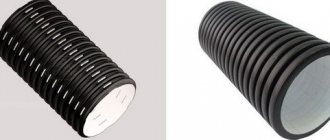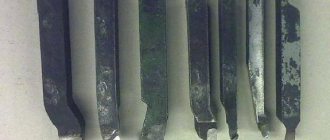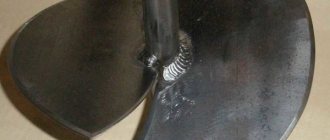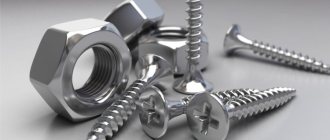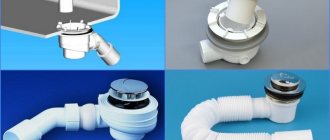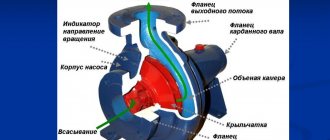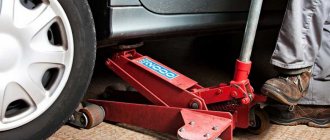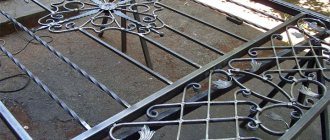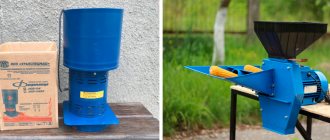What types of shovels for excavation work exist and what their differences are depending on the design, you need to know when choosing the best tool for a particular case.
Understanding what qualities a comfortable shovel should have will further simplify the purchase and avoid wasting money.
An inconvenient tool that is not suitable for a person not only leads to unnecessary physical exertion, but also threatens injury.
Cutting
The handle of a shovel is its handle, which can be made of wood, metal or plastic. For ease of use, many models have an additional T-shaped or forked handle installed at the end of the handle.
The cutting is made monolithic, from a single piece of material or from several tubes. In the second case, when transporting the tool, its handle can be folded, just as is done with modern telescopic fishing rods. The folding handle allows you to adjust the height of the handle to the height of the person using the shovel, which increases the comfort of working with it.
The metal handle is lightweight and durable. However, its disadvantage is that if it breaks, it cannot be repaired. In cold weather, it is difficult to work with a shovel with such a handle, as it greatly cools your hands. The cost of a metal handle is quite high.
Wooden cuttings are cheap. They are quite heavy. Their advantages will be the absence of cooling of the hands of those working in the cold season and ease of replacement in case of breakdown.
Due to the fact that a shovel is not a high-tech tool, many do not consider it necessary to approach its selection with due care. However, this is the main mistake of the owners, who did not pay a little more attention to this event, because a thoughtful choice of a much-needed tool in everyday life will not only save precious time and make work on the site easier, but will also allow you to enjoy it. To prevent possible mistakes, in this article we will talk about how to choose a shovel, as well as new technologies in the production of a seemingly simple tool.
Content
- A shovel is an indispensable tool. What do you need to know when choosing a shovel? video
- The bucket is an important part of the shovel. Deciding on the type of blade
- What do you need to know about cuttings?
- Basic types of shovels. Bayonet, shovel, sapper
- How to choose the right snow shovel?
A shovel is an indispensable tool. What do you need to know when choosing a shovel?
Every owner should know that when starting construction or any work on his personal property, first of all he must purchase a shovel. This is due to the fact that a shovel is a universal tool necessary both for lifting and moving any bulk materials, and for planting crops, during which you have to dig holes, loosen the soil and carry out many other necessary activities. Construction will also not be complete without the use of a shovel, which is a hand-held tool consisting of a handle, a bucket and a steel handle. The bucket is considered the fundamental part of the shovel, for the manufacture of which metal or plastic is used, and differs in shape depending on the purpose of the tool.
Before choosing and buying the right shovel, you need to familiarize yourself with the main types of this tool, their distinctive features and their typical characteristics. All shovels can be divided into several types depending on the shape of the bucket and the material from which it is made.
The variability of its shape is extremely high: you can find shovels with a narrow or wide bucket, blunt or slightly pointed. A shovel, the typical characteristics of which include a slightly concave wide bucket, is suitable for moving heavy bulk materials, and work in thickets will be greatly facilitated when using a narrow shovel. Thus, before buying a shovel, decide on the type of work that you plan to do using the selected shovel.
The bucket is an important part of the shovel. Deciding on the type of blade
Experts know that another important nuance that requires close attention is the type of blade. It also depends on the direct purpose of the shovel, and the quality of digging directly depends on this typical characteristic.
The bucket of the cheapest shovel is made of steel or ferrous metal. The easiest test to check the quality of such a shovel is to lightly tap the blade of the shovel - if the sound is clear, then you have a light and durable tool.
Currently, manufacturers offer shovels made of lightweight composite material that have a steel blade sharpened like saw teeth. This shovel is suitable for owners of neglected areas with a lot of weeds, as well as areas with a predominance of clay and turf soils.
The know-how of modern manufacturers has become the production of shovels from titanium. The main advantage of a titanium shovel is its high strength and lightness, unlike traditional shovels. The service life of tools in the manufacturing process of which titanium alloy was used increases significantly, which also cannot go unnoticed. Titanium, unlike stainless steel, is characterized by higher wear resistance, and, of course, does not corrode and does not rust. But the only disadvantage, relevant for many categories of citizens, remains the high cost of such an instrument. But, as practice shows, if you have not purchased a fake, a titanium shovel is a fairly worthwhile investment. To make the right choice and not be deceived by an unscrupulous seller, run a metal object along the blade of the shovel and examine the material in detail for scratches. If you still don’t have them, you can safely purchase this high-quality tool.
The shape of the blade is also an important quality characteristic of a shovel. Tools with a round blade are best used when working on hard ground, while using a shovel with a rectangular blade makes it easier to practice working in loose soil.
What do you need to know about cuttings?
An equally important part of the shovel is the handle. It must be remembered that the load on the legs and the musculoskeletal system experienced while working with this tool directly depends on the length of the handle. The shovel handle can be short, which is convenient when transporting tools, but not relevant for long-term and constant use, or long, less convenient during transportation, but great for everyday work.
It allows you to work at some distance and forms a large lever, which reduces the load on the legs and lower body. It is also important to pay attention to the coating of the handle, which will prevent damage to the material and splinters from getting into the skin. The recommended material for covering the handle is varnish or paint.
Main types of shovels. Bayonet, shovel, sapper
If your plans do not include purchasing several shovels for different types of activities or the size of your site is not designed to store a large number of tools, a bayonet shovel will be the ideal choice for you.
It is a universal tool, the design features of which allow you to perform any type of work, from planting and replanting plants to digging ditches and many other household works. The bucket of a bayonet shovel can be round, rectangular or pointed. A shovel with a pointed bucket is easier to destroy weeds along with their root system, a rectangular one is convenient for breaking up clods of dried earth, and a rounded shovel is the best tool for digging up soil.
The shovel with the best sales dynamics is called a shovel or universal sand shovel. The shovel is the most commonly found shovel on all construction sites and is used to move any bulk materials such as sand, soil or gravel. Another area of using a shovel is leveling the top layer of soil and forming ditches. The owners note that a shovel cannot be replaced by a bayonet shovel, despite the fact that the latter is recognized as a universal tool.
Sapper shovel,
can be equipped with a folding handle, was originally used by archaeologists and the military, but has recently gained exponential recognition among travelers and fishermen. The sapper shovel bucket is characterized by a pointed triangular shape and sharp jagged edges on one side. This unusual shape allows you to work in difficult terrain, and the presence of jagged edges allows you to use this shovel like a saw.
Large sapper shovel (BSL)
How to choose the right snow shovel?
It is important to mention the snow shovel, the sales of which increase sharply in winter. If at this time you are often faced with the problem of snow blockages that prevent the entry or garage doors from opening, as well as the inability to walk along garden paths, you need to resort to using a standard snow shovel. But here, too, certain problems arise related to the correct choice of such a shovel. Not many people know that shovels with a plastic bucket are not intended for work related to removing snow and ice; the plastic bucket quickly deforms under the influence of high loads.
Despite the higher cost and susceptibility to corrosion, the best choice is a metal snow shovel, which, with proper care, will serve you for many years.
Author: Sergey and Svetlana Khudentsov
0
Canvas
The main working part. Its shape varies depending on what a particular model is intended for. Thus, the classic digging shovel, familiar to every gardener and gardener, has a smooth, pointed blade, which is sharpened along the edge to make it easier to enter the ground. If the tool is intended for raking and loading bulk materials, then its blade will have the shape of a bucket.
The presence or absence of blade sharpening depends on the purpose of the shovel. If it is sharpened, then its sharp edge is called a blade. Sometimes there is a bend in the upper part of the canvas, which is called an advance. Not every model has it. A step is required to apply pressure with the foot on the blade when it is inserted into the soil when digging.
The main requirement for the canvas is lightness and strength. Because of this, the optimal material is steel, which is not subject to corrosion and is not expensive. Therefore, steel shovels are the most popular. Based on the quality of the metal from which the canvas is made, it is divided into the following types:
- rail steel - its characteristics are similar to the material from which railway rails are made. It is characterized by maximum strength and complete resistance to corrosion. This fabric is inferior in quality only to titanium, which is lighter with the same characteristics;
- hardened steel - the main purpose of a sheet of such metal is to work in the garden and vegetable garden with various types of soil. Not suitable for particularly heavy loads;
- polished steel is the best option for working with sticky soils, including clay;
- stainless steel - used in the manufacture of shovels intended for working with aggressive materials that will damage plain steel and render the blade unusable;
- with powder coating or Teflon coating - even the most sticky primer does not stick to such a surface.
You should not try to save on blades, since if the quality of the working part of the shovel is not suitable, the tool will simply be thrown away.
Characteristics of a garden bayonet shovel
The characteristics and conditions of use of bayonet shovels primarily depend on the material from which they are made.
- The main material for making shovels is steel. High carbon tool steel is excellent for garden tools, both in terms of wear resistance and strength. As a rule, such shovels last a very long time and can be used in very extreme conditions. The width of a steel shovel can be varied, everything will depend only on the goals that the consumer needs to solve.
- The next material from which a shovel bayonet can be made is titanium. Titanium tools are not inferior to steel ones in terms of strength properties and wear resistance, but they are significantly lighter. It can also be used in very harsh environments without worrying about damage. Perhaps the only and very serious drawback of a titanium bayonet is its high cost.
- Aluminum also works well for certain types of shovels. These assembled shovels are lightweight, which allows them to be maneuvered very effectively for a long time without fatigue. A serious disadvantage of aluminum shovels is their low strength and wear resistance. In this regard, aluminum tools are suitable for very light work, for example when loading/unloading feed mixtures, sawdust, light fillers, etc.
It is customary to use wood as cuttings for bayonet shovels. It is cheap, quite durable, lightweight, i.e., as a material for a handle, it is perfectly suitable. But today you can increasingly find a steel or aluminum handle on a bayonet garden tool. The use of metals as a tool handle is due to the fact that the metal handle can withstand higher loads compared to wood and, therefore, is more durable.
Important! Many car owners prefer to take bayonet shovels with a telescopic handle. It does not take up much space in the trunk, but if necessary, its importance is very difficult to underestimate
The shape of the cuttings can be straight or curved. The most common option is a straight cutting. However, the curved one, from the point of view of operation, is more profitable, since the load on the user’s hands is less.
The standard width of a bayonet shovel is from 230 to 280 mm, and the length is from 300 to 320 mm. Anything smaller than these dimensions is classified as a garden or sapper tool. Larger shovels have a lot of weight, and this, in turn, is unlikely to speed up the work.
Types of shovels for excavation work
Table 1. Types of shovels and their purpose.
| View | Purpose |
| Bayonet | Digging the earth in depth with separation of layers |
| Sovkovaya | For raking soft loose soil, carrying it and loading it |
| Drainage | Digging and cleaning trenches for water drainage |
| Sapper | For digging in on the battlefield without having to stand up |
| Stripping | Clearing sites during archaeological excavations |
| Miracle shovel | Digging and loosening the soil |
| Automotive | It is used when it is necessary to dig out car wheels from the mud when driving along country roads. Also allows you to get out when slipping in the snow |
Purpose of the scraper
Essentially, a scraper is a wide shovel for removing snow. True, it is devoid of a cutting as such. Instead, the scraper uses an arched handle, which makes it convenient to push the pile with a bucket. Upon reaching the edge of the area to be cleared of snow, you simply need to tip the bucket over, dumping the snow.
The scraper copes well with large volumes of fresh and loose snow. But a compacted one will already cause problems, since there is no necessary lever for emphasis. The scraper can only push the snow.
It is worth noting that there are certain hybrids of shovels and scrapers. Their design is designed in such a way that it is possible to lift snow to a small height, as well as move large volumes along the surface.
Bayonet
This is the most common type of shovel, without which it is impossible to properly dig an area or dig a hole. They are used in construction work, as well as agricultural work. The name “bayonet” appeared due to some external similarity of the instrument blade with a bayonet.
The height of the tool handle ranges from 110 to 150 cm. When choosing, you should be careful, since if the shovel turns out to be uncomfortable, the work will provoke injuries to the back muscles.
The tool blade may have additional stiffening ribs located on both sides. This increases the strength of the tool. Such models are most often chosen in the production of construction bayonet shovels. They are used at construction sites not only for digging up soil, but also for working with cement mortar.
Ancient types of shovels in Russia [edit | edit code]
A standard wooden shovel or blade was 6-14 inches wide and 8-16 inches long, with a total length including a handle of 1½-1¾ arshins. Shovels and paddles were made primarily from aspen, less commonly linden and birch, and even more rarely oak and maple.
Types of shovels: yard, or dirty, black - for shoveling manure, snow, etc.; oven, or bakery, - pekhlo (Vologda province) and grain - shuflya (Grodno), with a blade hollowed out by a trench, for raking bread in barns and barns, as well as for pouring (“vyshuflevats”) water and other things; winnower (Grodno) - a small-sized winnower with a cleaner finish for winnowing grain, and others.
The making of shovels (with a light hatchet, a mower, and partly with a large knife) was especially developed in the provinces: Tver (Vyshnevolotsk district annually delivered 100,000 pieces for the needs of the Nikolaev and Rybinsk-Bologovskaya railways), Ryazan (Ryazan, Kasimov and Yegoryev districts), Kaluga (Zhizdrinsky, Kozelsky, Likhvinsky and Meshchovsky districts), Tambov, Voronezh and Saratov (northern districts).
The shovel is perhaps the most commonly used hand tool for a variety of jobs around the world. On the other hand, it is not even entirely correct to call it one instrument, since there are many types of such devices. And although they are all similar, at first glance, if the model is selected incorrectly, it will quickly become obvious that there is a difference.
Sovkovaya
The blade of a shovel is usually metal, but in rare cases it can also be plastic. It is located at an angle to the handle. This tool is designed for carrying soil and bulk materials, loading and raking them. They won't be able to dig the ground. The edge of the canvas is not sharpened.
The exception is the American shovel. This model is made with a special bend of the blade and a sharp edge, which allows it to be used instead of a bayonet. This tool has a Teflon coating that prevents soil from sticking.
For additional convenience, there is a soft foam ring on the handle, which prevents the appearance of calluses on your hands during work. The American is also convenient when working with compost, when it is spread and dug into the soil with one tool.
In winter, special snow shovels are used to remove snow. They are often made of high-strength plastic, which avoids freezing of the snow mass to the canvas.
Loading and unloading
This type includes all shovels that are used for loading and unloading various materials. These are rock shovels, grain shovels, sand shovels, coal shovels, metallurgical shovels, snow shovels, and mining shovels. Since the products are similar in purpose, design, and operating principle, we will consider only a few of them, namely: a snow shovel and a shovel.
The first version of the weapon is distinguished by an enlarged blade made of various sheets of plywood, aluminum, and plastic. Snow shovels are the easiest to use and maintain. Their main purpose is to remove freshly fallen snow, but models with aluminum blades allow you to remove wet, compacted snow.
A shovel, also called a shuffle shovel, a pick-up shovel, is a blade resembling a scoop attached to a holder at an angle of 118° to 126°. The edges are folded, making it easier and more convenient to clean the surface, mix the solution, pick holes, and auxiliary work. This weapon is a record holder in terms of functionality.
Sapper
The sapper blade is an army tool, the need for which has arisen since the advent of rapid-fire firearms. Under these conditions, it was necessary to find a way to quickly create shelters in the field with minimal risk to the soldiers.
Then a new model was developed - a sapper shovel. It turned out to be much more practical than standard-sized shovels, when working with which it was necessary to stand up to full height. The first patent for a design of a sapper's shovel was issued in Denmark in 1860.
Rating of the best models
There is a rating of the most reliable and proven bayonet shovels. It is compiled based on the manufacturer’s reputation and user reviews.
- The first place is deservedly taken by the instrument of the Finnish manufacturer Fiskars. In particular, the Fiskars Solid shovel currently has a lot of positive feedback from users. It is a shortened model that fits perfectly into the trunk of a car, since its length is only 84 cm. However, despite its modest size, it copes very effectively with all types of soil. Fiskars is made of durable high carbon steel and powder coated. The handle is made of plastic, pleasant to the touch, which is not inferior in strength to steel. At the end of the handle there is a handle that increases the ergonomics of the tool. In addition, the shovel has an excellent bend in the handle, making it easier to work with. Thus, the shovel made in Finland takes a well-deserved first place.
- Second place undeniably goes to the Gardena tool. Her Terraline shovel could be in first place, but due to its high cost it is here. The distinctive features of this model include a very sharp bayonet made of steel with a corrosion-resistant coating. The Garden shovel has wear-resistant pads under foot pressure, which prevent the foot from slipping. The handle is made of plastic, at the end of which there is a removable ergonomic handle. The color of the instrument also leaves only positive emotions.
- Truper ranks last among the winners. The Trooper shovel consists of three materials at once: high-carbon steel, wood and plastic. The handle has a coating that prevents your hands from slipping. The bend of the shovel promotes comfortable work.
- In fourth place is a very high quality shovel from the Kuzbass company. The creation of a domestic manufacturer is not expensive. For literally pennies, the user receives an all-metal tool that will definitely not break. The blade is located at a slight angle relative to the handle, which makes work easier. The Kuzbass shovel has teeth on the blade that allow you to effectively cut tree roots. It is also important that the manufacturer gives a 3-year warranty on the product and refers to GOST.
- The second domestic manufacturer SibrTech occupies fifth position. The SibrTech shovel is made of high-quality materials. It has a steel handle that is equipped with a handle for ease of use. The handle has an anti-slip coating. It also has a bend in the handle and a ledge for the foot. The price-quality combination of this tool is not bad, but there are a lot of negative reviews on the Internet about the quality of the shovel bayonet steel.
- The very convenient and mobile Palisad shovel has captivated everyone with its reliability, versatility and small size. It is an ideal option for travelers and motorists. The Palisade shovel will fit into the trunk without any problems. The only downside of the product is its slightly overpriced.
- Zubr's shovels occupy a rather shaky place (they might not have made it into the rating at all). Most reviews about this tool are positive, but there are also negative ones, for example, many note the heavy weight, that the purchased shovel requires sharpening, and at the same time it is not exactly a budget option. The Zubr shovel has high strength and hardness, which allows it to dig most types of soil. In addition, there have been cases when the shovel bayonet split when working with hard rock. But as a garden tool, this shovel can be used for as long as you like and without complaints.
Zachistnaya and others
- Stripping. One of the varieties of bayonet shovel, which has a horizontally square cutting edge of the blade. Most of all, this type of tool is used during archaeological excavations, when it is necessary to clear a large excavation area.
- Kopalnaya. Also a type of bayonet shovel. It has a construction purpose and is used for digging foundations and similar work. The point can be round, sharp or straight. The blade has a slight forward slope in relation to the handle.
- Vykopochnaya. Also applies to bayonet ones. Its design allows you to capture as much soil as possible at once and remove it out, forming a hole. Because of this, the blade has a rounded shape rather than a wedge-shaped one.
- Sadovaya. It has a minimum length of 40 cm. It is intended for amateur work in the garden, when it is necessary to dig a small hole or dig up a bush for replanting. Just one such shovel is not enough for gardening work, and to cultivate the area you must also have a full-fledged bayonet shovel for digging up the soil and loosening it.
Classification of shovels
First, it’s worth understanding what a shovel is. A shovel is a tool for manual digging of soil, as well as clearing various types and types of areas from foreign materials: debris, earth, snow and other things. Essentially, this is a canvas, mostly metal, attached to a handle, which in Russia is most often made of wood.
For your information! This instrument has been used since very ancient times, when it was made from wood, bone (from an animal shoulder blade), elk horn, etc.
Of all the existing hand tools, shovels are perhaps one of the most necessary. With their help, you can do anything: dig up soil, cut it, dig a hole, make beds, hill up bushes and trees in a summer cottage, clear the area of snow, scatter sand, crushed stone, manure, gravel and humus around the site.
You can survive in extreme conditions with the help of special types of this tool by digging a dugout, cutting down a tree and cutting up a hunting trophy. In military conditions, it can be used in combat, defuse ammunition and dig a trench. You can take the finished bread out of the oven, use it in steel smelting, or put out fires. Truly, it is an indispensable tool. It's hard to find a more common piece of equipment with such versatility.
All about shovels
Like any other tool, shovels come in different types and shapes, which offer a variety of uses and purposes. Among the main types of shovels, the following are primarily distinguished:
Bayonet shovel
It has a working part made of metal, mounted on a handle, most often wooden. This is the most common type of garden shovels for working in the field, vegetable garden, and garden. Used in agriculture, homestead farming and in excavation work. The main part is pointed towards the center in order to cut into the ground with great force, which is not the case with other types of shovels.
Among bayonet shovels, titanium shovels have recently become increasingly popular due to their low weight, high strength, low metal adhesion, durable sharpening, and rigid metal part. The disadvantages of titanium shovels are their high price and fragility.
Note! Also among bayonet shovels there is a type called a drainage shovel. It has a durable working part with an extended collar, which allows you to conveniently dig narrow ditches and trenches. Such shovels from Truper are popular among manufacturers.
For the hardest and toughest soil, special soil cutting shovels are used. These include the Vyatka Plowman shovel, which is used for manual digging of soil for planting agricultural plants and for cleaning shallow trenches. It has a ploughshare and is designed for only one working leg. After digging the soil with it, it looks as if it had been tilled with a walk-behind tractor.
Truper shovels
Spade
This is a fairly old type of instrument and is practically not used today. These are shovels with special edges that require pressing with your foot, allowing you to cut into the ground with even greater force. The working base of the spades is made in the form of a rounded cutting edge, which allows it to be used more effectively for digging even the hardest soils. There are spades with a long blade and with working bases curved forward. As a rule, these are quite large shovels in size.
Small infantry shovel, or sapper shovel
It is usually 50 to 60 cm long, so that it can be carried constantly on a belt or in a case. The instrument consists of a wooden handle and an iron base, pointed towards the center. It is used for digging various types of soil, as well as quickly digging trenches, digging up mines and ammunition and their prompt disposal.
Note! Sapper shovels are used not only in the army, but also in folk medicine, since with their help many herbalists dig up the herbs and roots of medicinal plants they need in forests and fields.
Snow shovel
Its working part is usually very wide, which is made of plastic, aluminum, various sheets of plywood, as they are the lightest and easiest to operate. The main task of such a shovel is to move as much snow as possible to clear the area of precipitation. Such a tool for collecting and removing snow, which does not have a tray, but simply a flat blade, is called a slider.
Important! Another type of shovel is a dustpan, characterized by a short handle, which is usually located across the general plane of the tool. It is used to dump trash that has been swept into a heap.
The official classification of shovels according to GOST 19596-87 is as follows:
- construction;
- gardening;
- loading and unloading.
Modern views
Modern types of shovels for excavation work deserve special attention.
- Miracle shovel. This is the name given to a unit with an intricate design, which at the same time not only digs up the soil, but also loosens it. However, first you need to get used to working with such a device. The unit cannot fully replace the classic gardener’s shovel. The device is more suitable for cultivating a large area in areas with light soil.
- Telescopic. The ability to adjust the length of the handle allows people of different heights to use one shovel. The tool blade is bayonet, designed for processing various types of soils. It is convenient to carry the tool with you in the trunk of your car. The disadvantage is the high cost and the impossibility of repairing the handle in case of breakage.
- With replaceable nozzles. This model has one handle and several different attachments on it. There is a thread on the handle to screw and unscrew the blades. By changing them, you get optimal shovels for certain jobs.
How to choose a bayonet shovel
The choice of tool depends on the type of activity performed.
If you need to routinely dig up the soil, which is needed, for example, in a summer house, the version of a classic shovel will suffice. For such needs, it makes sense to take a tool that is more reliable and more expensive, so that the next purchase is not coming very soon, for example, you can buy shovels from Fiskars or Gardena, which combine excellent price and quality. Constant work with hard rocks requires the appropriate tools
In this regard, your attention should be paid to reinforced versions of shovels, the strength characteristics of which significantly exceed the classic ones. To extract a large amount of soil at one time, you should take a closer look at the American type of bayonet shovel
Note! For traveling conditions or constant transportation in the trunk of a car, a lightweight bayonet shovel or with a telescopic handle would be an advantageous option. The dimensions of these shovels are very small, so they can fit both in a car and in a backpack.
By size and weight
When choosing, be sure to pay attention to the weight of the tool. When it is significant, a person working with such a shovel quickly gets tired and the productivity of his work drops. If the tool is very light, then this is an indicator of its low quality and fragility.
It is optimal for an excavation shovel to be felt in the hand, but not perceived as heavy. This indicator is individual for everyone, and therefore it is necessary to hold the product in your hand for at least a few minutes before purchasing. The feeling of a good shovel will not change in the direction of making it heavier as your hand gets tired.
Mechanized types
To facilitate snow removal, several types of mechanized means have been developed.
For example, a regular auger was attached to the scraper and the result was a small snowblower. The working method is similar to a classic scraper - you need to push it, and the auger will send the debris to the side. However, there are also limitations - compacted snow and its thick layers will be quite difficult to remove.
Wheeled versions of scrapers made it possible to reduce the friction force and, accordingly, the amount of effort applied. Among them we can distinguish a snow shovel with one, large wheel installed between the bucket and the handle. The device is easy to roll, has a lever for lifting, and also has good maneuverability.
Well, at the top of the “snow removal chain” there are electric shovels . Probably the most convenient, but at the same time expensive way to remove snow. They have the following characteristics:
- ease of operation, the auger throws the snow to the side itself;
- minimum effort;
- compact sizes.
However, they are very expensive, require a power source and more careful handling.
By purpose
Depending on the purpose, a bayonet, scoop or other shovel is purchased. So, a classic instrument is not suitable for a motorist - due to the long handle, it is inconvenient to store it in the trunk of a car.
Also, a car or engineer's shovel is not suitable for digging up a site or digging a pit for a foundation or a swimming pool. If you need to have several shovels, you can purchase all of them or one tool with interchangeable attachments.
The material from which the canvas will be made is also of great importance. When the soils on the site are predominantly sticky, then preference should be given to a model with additional coating. You should not skimp on the quality of the shovel blade.
Made from low-quality metal, it will deform during operation and quickly become dull. In this case, the tool will not be able to fully cut through the soil and digging up the soil will require a lot of effort.
Special purpose
Tools that are used in military, extreme conditions, or to perform a specific function. Military shovels, in turn, are divided into two more types: sapper, infantry. With their help you can not only dig a trench, but also protect yourself from the enemy; their high quality allows them to be used as a weapon. In addition, sapper tools are often used in folk medicine; they can easily be used to dig up medicinal herbs in fields and forests.
Tourist products are combined folding devices that combine an ax, saw, bayonet, scoop and other tools. The product may have a telescopic and foldable design. An indispensable thing in the wild. Tools can be used to chop, cut, dig. The latter type includes shovels of bakers, steelworkers, firefighters, paper clips and other products.
Caring for the implement
In order for the tool to last as long as possible, it is necessary to keep it dry and completely clean, and also follow several rules.
- Clean after use to prevent the tool from becoming oxidized by organic matter and moisture.
- Store in separate, not too large rooms.
- Straighten and sharpen the working edge in a timely manner.
- Stably color and strengthen the cuttings.
The best manufacturers
Russian-made shovels are much cheaper than their imported counterparts and are only slightly inferior in quality.
- Bison A Russian company that produces high-quality shovels and a number of other tools.
- Center tool. Manufacturer of garden tools using only modern technologies.
- FIT. A Canadian company specializing in gardening tools, including shovels.
- Master Amaz. A Russian manufacturer that uses European technologies in the production of gardening tools.
- Fiskars. A Finnish company that is considered a world leader in the production of many tools, including garden tools and shovels.
Variety of shovels
All shovels have a similar design: a working metal part attached to a handle. However, they all differ in the configuration of the plate and the length of the handle, as well as the metal from which they are made. The type of shovel depends on the area of its application.
Bayonet
This type is characterized by a pointed metal bayonet with curved blades on the sides and a wooden handle. Used for digging deep into dense soil. Gardeners use it to dig up crops or plant plants, and they also use it to plow small areas of land. Spades or crossbars prevent soil from sticking while digging. Titanium bayonet shovels have become popular models of this type of shovel. They are lightweight, durable and comfortable to use. The plate does not rust or deform from the weight of the soil. The total length of the shovel is 640-1600 mm, the length of the bayonet is 180-260 mm, the weight is 1-2 kg.
Sovkovaya
This shovel is also called a pick-up or shuffle shovel. Its metal part is rectangular and shaped like a scoop at an angle of 120-125 degrees to the handle. The edges of the plate are bent. It is convenient for mixing mortar, selecting various bulk substances such as sand, crushed stone or screenings, cleaning the surface or removing soil from a hole, removing grain or spreading fertilizer. It is the most multifunctional among all types of shovels. Not a single construction site, cottage or garden is processed without the use of a shovel. The length of the shovel is 800-1600 mm, the length of the metal plate is from 190 to 460 mm and its weight is 1-4 kg.
Snow removal
A large canvas in the form of a bucket, which is made of lightweight materials such as plastic or aluminum to which the handle is attached. Used for clearing snow from sidewalks or roads. It is a type of shovel, as it has similar functions and appearance. The edge of the canvas is treated with a metal strip to protect it from deformation. There are shovels of this type with two handles and a very wide blade. They are often called scrapers. They are designed to clear large areas of snow. The bucket of such a shovel has skis or wheels that help the tool slide even when heavily loaded with snow. When working on frozen snow, do not use snow shovels. There are special tools for this - ice axes, otherwise your shovel will quickly fail. The length of the shovel is 750-1600 mm, the length of the bucket is 275-800 mm and the weight is 1-6 kg.
Sadovaya
It was invented with the goal of creating one universal shovel from a bayonet and a shovel. It combines the functions of digging soil and carrying bulk materials. It is equipped with a transverse handle at the end of the handle to increase the pressure during operation.
Special purpose shovels
In addition to shovels widely used in farming, there are also highly specialized types that are used exclusively in one field of activity.
Military shovels
They are divided into two types: infantry and sapper. The sapper shovel is still an invariable attribute of soldiers. However, due to its versatility and ease of use, it has become very popular among tourists, fishermen and hunters. The metal plate of the shovel has a pentagonal shape and a V-shaped handle, which allows you to place a stronger emphasis. Also, its compactness due to the folding mechanism facilitates its attachment to a hiking backpack. The length of the sapper shovel is about 550-620 mm, the length of the plate is 120-145 mm, the mass is 0.5-2 kg.
Tourist shovels
No camping trip or expedition is complete without a tourist shovel. This is a modernized product that combines many tools at once - a scoop, a saw, an ax, a bayonet, a hoe, a pick and more. It can be used to clear a place for a fire, and dig ditches around tents, to drain rainwater, and cut branches for fire, and much more. The folding design and special case allows you to place it inside a backpack or bag. The length of the shovel is 40-70 cm, the length of the platinum is 13-16 cm, the weight is about 1.5 kg.
Car shovel
This is a special tool that can often be found in the trunk of a car. It is not very heavy and long. The handle is made in the shape of the letter V. This allows you to apply strong pressure and emphasis while working in extreme situations. Used by drivers to dig out wheels when stuck in sand, snow or mud. A car shovel is similar in versatility to a tourist shovel. It has a flat rectangular blade made of durable metal and a wooden or plastic handle. The total length of the shovel is 660-1000 mm, the length of the bayonet is 145-210 mm, weight is up to 1 kg.
Reviews
- Elena
When we bought a dacha, the question arose about what equipment to buy. The garden center recommended a Finnish-made shovel. She is, of course, expensive, but I didn’t regret it. It digs great. We've been using it for several years now and it hasn't lost any quality.
- Oleg
I fell for the attractive advertisement and ordered myself the famous Miracle Shovel. Of course, I didn’t notice any miracles other than wasted money, it’s definitely not worth it, I’m much more comfortable with a simple bayonet.
The efficiency of excavation work depends on the correct choice of shovel. It is necessary to pay attention to the material from which the blade and the handle of the tool are made.
See recommendations for choosing shovels:
What you need to know about shovels?
Shovels also include dustpans.
The handle of such a tool is fixed across the plane of the canvas with sides.
The materials used for manufacturing are plastic and metal.
The first option is monolithic.
In other words, the plastic scoop has a non-separable cast design.
To harvest potatoes, a special shovel is used, which is similar in appearance to a pitchfork.
At the end there is a partition with rollers.
Used together with wooden tools on vegetable bases.
Shovels are also called various scrapers for cleaning hard-to-reach places from debris and dirt, intended for raking.
Modern tourist shovels are equipped with additional attachments.
Their design allows you to remove a standard blade from the handle and attach an ax, saw or other useful travel tool that comes with the set in its place.
In addition to ordinary hand tools, you can find various modifications on the market:
- Pneumatic shovel (pneumatic bucket, hopper bucket, plaster shovel) – a device for applying plaster. It is a handle on which the scooping container is attached. Inside it there are nozzles for supplying the solution and air nozzles.
There is a tube installed in the handle that supplies compressed air from the connected compressor. - An electric shovel is a small snow blower with an electric drive and a handle similar to a holder.
Outwardly, it is similar to a manual snow removal tool, however, it does not require any physical effort to remove snow, i.e. This is one type of snow blower. Read about all types of snow blowers here
Care and storage
Shovels should be stored in a dry, clean and well-ventilated place. It is best to set aside a separate place to store all garden tools. In order for the shovel to serve you for a long time, you should follow some rules of care:
- Always clean your shovel after use. Moisture and organic substances that remain on the surface and act destructively on the shovel.
- If the handle of your shovel is made of wood, it will need to be painted and strengthened periodically. Make sure it stays tight and doesn't wobble. If it becomes loose, reinforce it with nails or bolts.
- Regularly sharpen the edge of the work plate, smooth out bends and dents. Sharpening is carried out using a grinder or rasp. If your shovel is not made of aluminum, steel or stainless steel, sharpening is not required.
- When purchasing, choose shovels with a solid crown. This shovel will last you two to three times longer. The junction of the handle and the plate is the most vulnerable.
Join our Facebook group
Shovel device
Each shovel combines three components - a metal or plastic blade, a wooden handle and a tulle. The canvas is a working component that directly affects the soil, snow or bulk materials. There is a tread on the canvas - this is an edge curved at a right angle, which is stepped on with the foot for greater pressure.
The tulleka is a fastening element that is located between the handle and the canvas. It connects the two parts, preventing the base plate handle from breaking. Tuleykas can be solid or patched. Solid ones are part of the canvas, and overhead ones are attached to the plate with rivets or bolts.
The handle is the handle of the shovel. It is made of light wood or multilayer plastic. Its function is to hold the entire shovel and point it in the desired direction when used. It is more convenient to use a T-shaped cutting. It makes it possible to place more emphasis on the product. This is useful when digging into hard ground.
Choosing a cutting
Metal. Hollow tube made of steel or alloy. The use of metal is justified by the need to give the handle a special shape that will facilitate the work.
Advantages:
- Convenient and reliable design.
- Light weight.
Flaws:
- Cannot be properly repaired. In the event of a breakdown, the weapon will have to find a new use.
- Cold metal freezes your hands when working in the cold.
- A limited set of sizes (lengths), usually three.
- High price. Shovels with metal curved handles cost from 15 USD. e. (China, 500 mm) up to 200 cu. e. (Canada, 1800 mm).
Conclusion - a shovel with a cast metal handle will pay for itself and will be relevant for skillful long-term work during periods of above-zero temperatures. Such a tool must be selected individually for the master, taking into account the range of tasks.
Wooden stalk. Round wooden block Ø 45 mm.
Advantages:
- Cheapness, availability (1 cu).
- Easy to replace.
- You can cut it to the desired length and install a cross handle at the end.
- You can use one cutting for several tools.
Flaws:
- All problems with wood*.
- Weight is greater than that of metal (up to 30%).
- Straight design only.
* Wooden handles are not durable because they are made from pine. Oak and birch handles of military shovels compete in strength with the hollow metal handles of “civilian” products.
Conclusion - although a wooden handle is not so convenient, the entire product is much cheaper. In this case, the design can be varied, for example, cut to the size of a mining shovel. Well suited where different people can use the same tool, or where there are a variety of tools.
